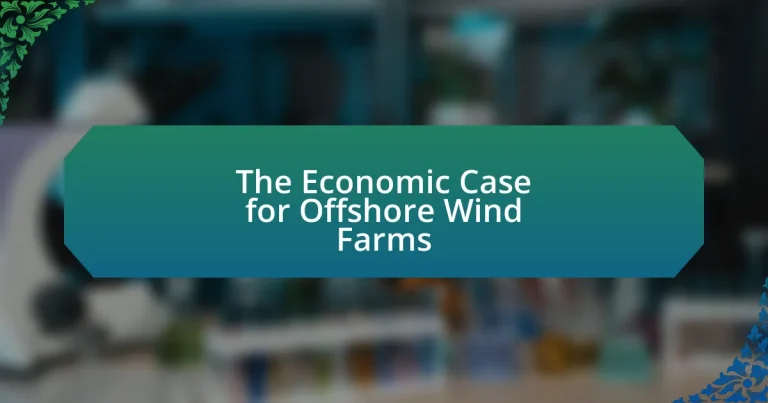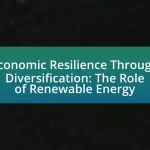The main entity of the article is offshore wind farms, which are increasingly recognized for their economic viability. The article outlines the strong economic case for investing in offshore wind energy, highlighting benefits such as lower electricity generation costs, significant job creation, and enhanced energy security. It discusses the potential for over 1.3 million jobs globally by 2030, the decreasing costs of offshore wind energy, and the role of government policies and financial incentives in supporting this sector. Additionally, the article examines the long-term economic impacts, including reduced greenhouse gas emissions and the stabilization of energy markets, while addressing the financial risks and best practices for maximizing economic outcomes in offshore wind projects.
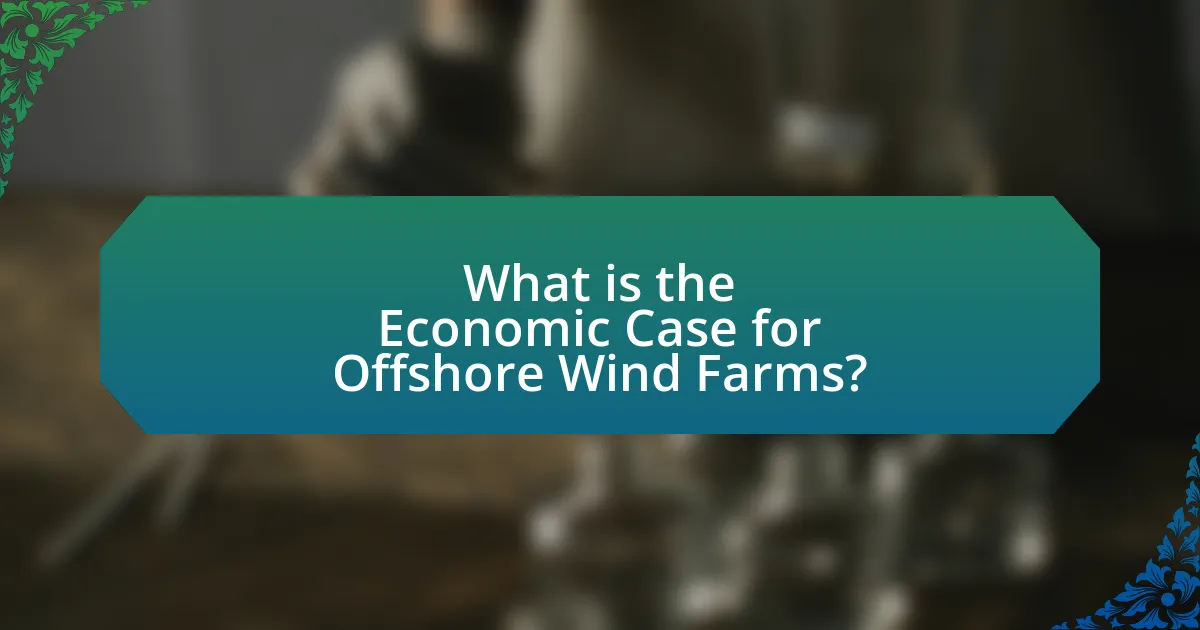
What is the Economic Case for Offshore Wind Farms?
The economic case for offshore wind farms is strong due to their potential for high energy output and job creation. Offshore wind farms can generate electricity at a lower cost per megawatt-hour compared to traditional fossil fuels, with costs dropping by 70% since 2009, making them increasingly competitive in energy markets. Additionally, the sector is projected to create over 1.3 million jobs globally by 2030, according to the International Renewable Energy Agency. This job creation spans manufacturing, installation, and maintenance, contributing significantly to local economies. Furthermore, offshore wind farms can enhance energy security by diversifying energy sources and reducing reliance on imported fuels.
How do offshore wind farms contribute to economic growth?
Offshore wind farms contribute to economic growth by creating jobs, stimulating local economies, and generating renewable energy that reduces reliance on fossil fuels. The construction and maintenance of these facilities require a skilled workforce, leading to the creation of thousands of jobs in manufacturing, installation, and operations. For instance, a report by the U.S. Department of Energy indicates that the offshore wind sector could support over 77,000 jobs by 2030. Additionally, offshore wind farms attract investments in infrastructure and technology, further boosting local economies. They also provide a sustainable energy source, which can lower energy costs and enhance energy security, contributing to long-term economic stability.
What are the key economic benefits of investing in offshore wind farms?
Investing in offshore wind farms generates significant economic benefits, including job creation, energy cost savings, and increased energy independence. The offshore wind sector is projected to create over 200,000 jobs in the United States by 2030, according to the U.S. Department of Energy. Additionally, offshore wind energy can reduce electricity costs by providing a stable and predictable energy source, which can lower overall energy prices for consumers. Furthermore, by diversifying the energy supply, offshore wind farms enhance energy independence, reducing reliance on fossil fuels and improving national security. These factors collectively contribute to a robust economic case for investing in offshore wind energy.
How do offshore wind farms impact local job creation?
Offshore wind farms significantly enhance local job creation by generating employment opportunities in various sectors, including construction, maintenance, and operation. For instance, a study by the National Renewable Energy Laboratory indicates that each megawatt of offshore wind capacity can create approximately 3.3 jobs during the construction phase and 0.5 jobs for ongoing operations and maintenance. This translates to thousands of jobs in coastal communities where these projects are developed, contributing to local economies and workforce development. Additionally, the growth of the offshore wind industry stimulates related sectors, such as manufacturing and supply chain logistics, further amplifying job creation in the region.
Why is the cost of offshore wind energy significant?
The cost of offshore wind energy is significant due to its impact on the overall feasibility and competitiveness of renewable energy projects. Offshore wind farms require substantial initial investments, often exceeding $3 million per megawatt, which includes expenses for technology, installation, and maintenance. Additionally, the levelized cost of electricity (LCOE) for offshore wind has been decreasing, reaching around $40 to $60 per megawatt-hour in recent years, making it increasingly competitive with fossil fuels. This cost-effectiveness is crucial for attracting investment and driving the transition to sustainable energy sources.
What factors influence the initial investment costs of offshore wind farms?
The initial investment costs of offshore wind farms are influenced by factors such as site selection, technology choice, regulatory environment, and project financing. Site selection impacts costs due to varying seabed conditions, water depths, and distance from shore, which can affect installation and maintenance expenses. The choice of technology, including turbine size and type, directly influences capital expenditure, as advanced turbines may have higher upfront costs but offer better efficiency. The regulatory environment, including permitting processes and local policies, can lead to delays and additional costs if not managed effectively. Lastly, project financing terms, including interest rates and investment structures, can significantly affect the overall capital required for development. These factors collectively shape the economic viability of offshore wind projects, as evidenced by studies indicating that projects in favorable locations with efficient technologies tend to have lower initial costs and higher returns on investment.
How do operational costs compare to other energy sources?
Operational costs for offshore wind farms are generally lower than those of fossil fuel-based energy sources but higher than onshore wind and solar energy. Offshore wind farms benefit from economies of scale and lower maintenance costs due to fewer operational hours compared to fossil fuel plants, which incur significant costs for fuel and emissions control. According to the International Renewable Energy Agency (IRENA), the levelized cost of electricity (LCOE) for offshore wind has decreased by 29% between 2010 and 2018, making it increasingly competitive with traditional energy sources. In contrast, fossil fuel plants face fluctuating fuel prices and regulatory costs associated with carbon emissions, which can elevate their operational expenses.
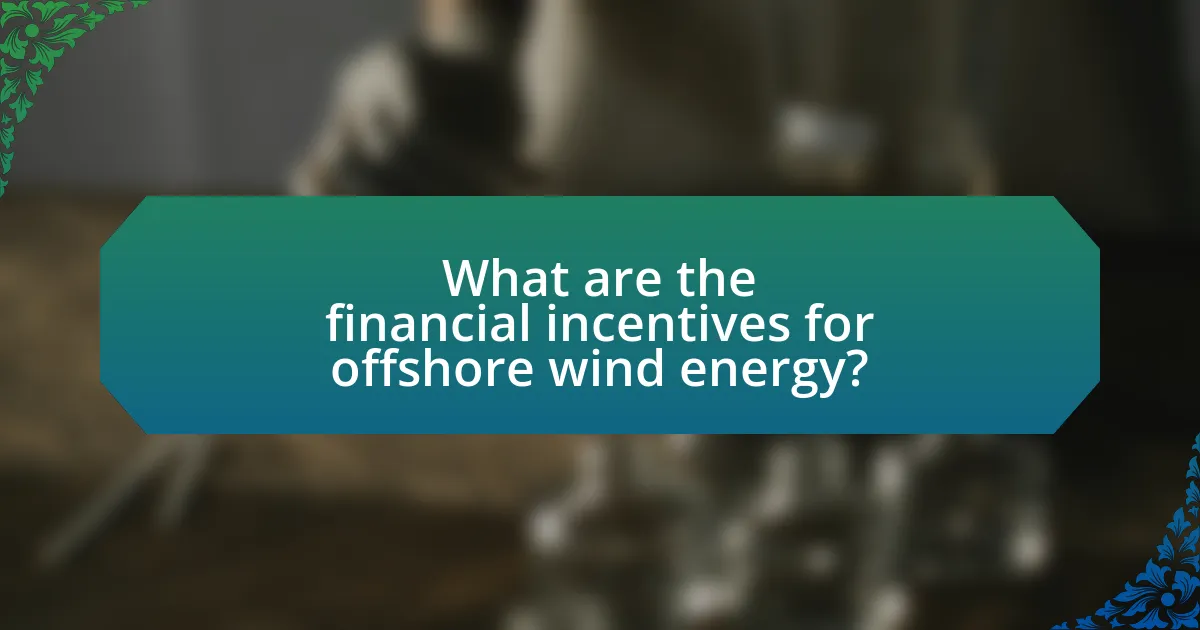
What are the financial incentives for offshore wind energy?
The financial incentives for offshore wind energy include government subsidies, tax credits, and long-term power purchase agreements. These incentives are designed to reduce the initial capital costs and enhance the economic viability of offshore wind projects. For instance, the Investment Tax Credit (ITC) in the United States allows developers to deduct a significant percentage of the investment cost from their federal taxes, which can amount to millions of dollars in savings. Additionally, many countries offer feed-in tariffs or contracts for difference, guaranteeing a fixed price for the electricity generated, thus providing revenue certainty for investors. According to the International Renewable Energy Agency (IRENA), the global offshore wind sector has seen a reduction in costs by approximately 30% since 2010, largely due to these financial incentives, making it increasingly competitive with fossil fuels.
How do government policies support offshore wind farm development?
Government policies support offshore wind farm development through financial incentives, regulatory frameworks, and investment in infrastructure. These policies often include subsidies, tax credits, and grants that lower the cost of project development and enhance financial viability. For example, the U.S. federal government offers the Investment Tax Credit (ITC) and the Production Tax Credit (PTC), which have been instrumental in promoting renewable energy projects, including offshore wind. Additionally, streamlined permitting processes and established renewable energy targets create a favorable environment for investment. According to the International Renewable Energy Agency (IRENA), countries with supportive policies have seen significant increases in offshore wind capacity, demonstrating the effectiveness of government intervention in this sector.
What types of subsidies and tax incentives are available?
Various types of subsidies and tax incentives are available for offshore wind farms, including investment tax credits, production tax credits, and grants. Investment tax credits allow developers to deduct a percentage of the investment costs from their federal taxes, while production tax credits provide a per-kilowatt-hour incentive for electricity generated. Additionally, grants may be offered by government agencies to support project development and research. These financial mechanisms are designed to reduce the overall cost of offshore wind projects, making them more economically viable and attractive to investors.
How do renewable energy credits affect the financial viability of offshore wind farms?
Renewable energy credits (RECs) significantly enhance the financial viability of offshore wind farms by providing an additional revenue stream. These credits represent the environmental benefits of generating renewable energy and can be sold to utilities or companies needing to meet renewable energy standards. For instance, in the United States, the federal Investment Tax Credit (ITC) and various state-level renewable portfolio standards create a market for RECs, which can increase the overall income of offshore wind projects. According to the U.S. Department of Energy, the availability of RECs can improve project financing conditions, making it easier for developers to secure investments and loans, thereby reducing the cost of capital. This financial support is crucial, as offshore wind farms typically require substantial upfront investments, often exceeding $3 billion per project. Thus, the integration of RECs into the financial model of offshore wind farms is essential for their economic sustainability and growth.
What role do private investments play in offshore wind projects?
Private investments are crucial for the development and expansion of offshore wind projects, as they provide the necessary capital to finance large-scale infrastructure and technology. These investments enable project developers to cover high upfront costs, which can exceed billions of dollars, and facilitate the construction of wind farms that contribute to renewable energy targets. For instance, in 2020, private investments accounted for approximately 70% of the total funding for offshore wind projects globally, highlighting their significance in driving growth in this sector.
How do public-private partnerships enhance funding opportunities?
Public-private partnerships enhance funding opportunities by combining resources and expertise from both sectors, thereby increasing investment potential for projects like offshore wind farms. These collaborations allow for shared financial risk, which attracts private investors who may be hesitant to fund large-scale projects independently. For instance, the U.S. Department of Energy has reported that public-private partnerships can leverage federal funding to stimulate private investment, resulting in a multiplier effect that significantly boosts overall project financing. This synergy not only facilitates access to capital but also fosters innovation and efficiency, making projects more viable and appealing to investors.
What are the risks and rewards for investors in offshore wind farms?
Investors in offshore wind farms face both significant risks and substantial rewards. The primary rewards include long-term stable returns, as offshore wind projects often benefit from government incentives and power purchase agreements that guarantee revenue over extended periods. For instance, the global offshore wind market is projected to grow from 35 GW in 2020 to over 234 GW by 2030, indicating a robust demand for renewable energy sources.
Conversely, the risks involve high initial capital costs, regulatory uncertainties, and potential environmental impacts. The construction and maintenance of offshore wind farms require substantial investment, often exceeding $3 million per megawatt, which can deter investors if not managed properly. Additionally, changes in government policies or public opposition can lead to project delays or cancellations, impacting financial returns.
Overall, while the offshore wind sector presents lucrative opportunities driven by the transition to renewable energy, investors must navigate the complexities of financial, regulatory, and environmental challenges.
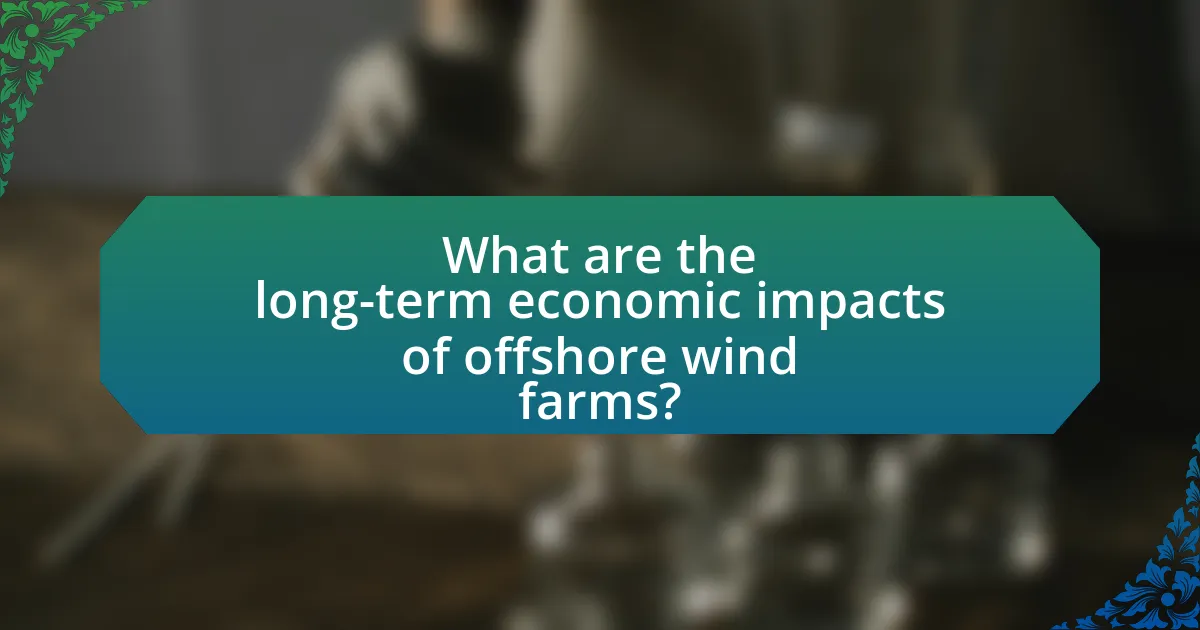
What are the long-term economic impacts of offshore wind farms?
The long-term economic impacts of offshore wind farms include job creation, increased energy security, and reduced greenhouse gas emissions. Offshore wind farms generate significant employment opportunities, with estimates suggesting that the sector could create over 200,000 jobs in the U.S. alone by 2030, according to the U.S. Department of Energy. Additionally, they contribute to energy security by diversifying energy sources and reducing reliance on fossil fuels, which can stabilize energy prices. Furthermore, offshore wind farms help mitigate climate change by decreasing carbon emissions, with a potential reduction of up to 78 million metric tons of CO2 annually in the U.S. by 2050, as reported by the National Renewable Energy Laboratory. These factors collectively enhance economic resilience and promote sustainable growth.
How do offshore wind farms affect energy prices in the long run?
Offshore wind farms generally lead to lower energy prices in the long run by increasing the supply of renewable energy and reducing dependence on fossil fuels. As more offshore wind capacity is installed, the cost of electricity generation from these sources has decreased significantly, with prices dropping by approximately 70% since 2009, according to the International Renewable Energy Agency. This reduction in generation costs contributes to lower wholesale electricity prices, as renewable energy sources often set the market price. Additionally, the integration of offshore wind into the energy mix enhances grid stability and reduces price volatility, further benefiting consumers.
What is the potential for offshore wind farms to stabilize energy markets?
Offshore wind farms have significant potential to stabilize energy markets by providing a reliable and consistent source of renewable energy. Their ability to generate electricity at scale can reduce dependence on fossil fuels, thereby mitigating price volatility associated with traditional energy sources. For instance, a study by the International Renewable Energy Agency (IRENA) indicates that offshore wind energy can provide up to 20% of global electricity demand by 2040, contributing to a more stable energy supply. Additionally, the predictable nature of wind patterns in offshore locations allows for better forecasting and integration into energy grids, further enhancing market stability.
How do offshore wind farms contribute to energy independence?
Offshore wind farms contribute to energy independence by generating renewable energy locally, reducing reliance on imported fossil fuels. By harnessing wind energy from coastal areas, these farms can produce significant amounts of electricity, with some projects generating over 1,000 megawatts, enough to power hundreds of thousands of homes. This local energy production decreases vulnerability to global energy market fluctuations and enhances national security by diversifying the energy supply. Additionally, the U.S. Department of Energy reports that offshore wind could provide up to 86 gigawatts of capacity by 2050, further solidifying its role in achieving energy independence.
What are the environmental economic benefits of offshore wind farms?
Offshore wind farms provide significant environmental economic benefits, primarily through the reduction of greenhouse gas emissions and the creation of sustainable jobs. By generating electricity from wind, these farms displace fossil fuel use, which is responsible for approximately 70% of global carbon emissions. For instance, a study by the National Renewable Energy Laboratory found that a 1,000 MW offshore wind farm can prevent the emission of about 2.6 million tons of carbon dioxide annually. Additionally, the offshore wind sector is projected to create over 200,000 jobs in the U.S. by 2030, contributing to economic growth while promoting clean energy. This dual impact of environmental sustainability and job creation underscores the economic viability of investing in offshore wind energy.
How do offshore wind farms reduce carbon emissions and their economic implications?
Offshore wind farms reduce carbon emissions by generating electricity from wind, which displaces the need for fossil fuel-based power generation. This transition to renewable energy sources significantly lowers greenhouse gas emissions, as wind energy produces no direct carbon emissions during operation. For instance, a study by the National Renewable Energy Laboratory indicates that a 1 GW offshore wind farm can prevent approximately 2.6 million tons of CO2 emissions annually, equivalent to removing over 500,000 cars from the road.
The economic implications of offshore wind farms are substantial. They create jobs in manufacturing, installation, and maintenance, contributing to local economies. According to the U.S. Department of Energy, the offshore wind sector could support over 77,000 jobs by 2030. Additionally, offshore wind farms can lead to lower electricity prices over time due to reduced reliance on imported fuels and the decreasing costs of wind technology, which have dropped by 70% since 2009. This combination of environmental benefits and economic growth underscores the value of investing in offshore wind energy.
What is the impact of offshore wind farms on marine ecosystems and local economies?
Offshore wind farms positively impact marine ecosystems and local economies. They provide renewable energy, which reduces reliance on fossil fuels, thereby decreasing greenhouse gas emissions that harm marine life. Studies indicate that offshore wind farms can create artificial reefs, promoting biodiversity by attracting various marine species. Economically, these farms generate jobs in construction, maintenance, and operation, with the U.S. offshore wind sector projected to create over 77,000 jobs by 2030, according to the U.S. Department of Energy. Additionally, they can enhance local economies through increased tourism and fishing opportunities, as some studies show that marine life flourishes around wind farm structures.
What are best practices for maximizing the economic benefits of offshore wind farms?
Best practices for maximizing the economic benefits of offshore wind farms include optimizing site selection, investing in advanced technology, and fostering local supply chains. Optimizing site selection involves choosing locations with high wind potential and minimal environmental impact, which can significantly enhance energy output and reduce costs. Investing in advanced technology, such as larger turbines and improved grid integration, can increase efficiency and lower the levelized cost of energy (LCOE). Additionally, fostering local supply chains can create jobs and stimulate regional economies, as evidenced by the U.S. offshore wind sector, which is projected to support over 77,000 jobs by 2030 according to the National Renewable Energy Laboratory. These practices collectively contribute to the economic viability and sustainability of offshore wind projects.
How can stakeholders collaborate to enhance economic outcomes?
Stakeholders can collaborate to enhance economic outcomes by forming partnerships that leverage shared resources, expertise, and investment in offshore wind farms. Collaborative efforts among government entities, private companies, and local communities can lead to streamlined regulatory processes, reduced costs, and increased job creation. For instance, a study by the National Renewable Energy Laboratory found that coordinated planning and investment in offshore wind infrastructure can lead to a 20% reduction in overall project costs, thereby improving economic viability. Additionally, stakeholder engagement in community outreach can foster public support, which is crucial for the successful implementation of offshore wind projects, ultimately driving economic growth in the region.
What strategies can be employed to mitigate financial risks in offshore wind projects?
To mitigate financial risks in offshore wind projects, developers can employ strategies such as securing long-term power purchase agreements (PPAs), diversifying funding sources, and utilizing insurance products. Long-term PPAs provide revenue certainty by locking in prices for electricity, which reduces exposure to market fluctuations. Diversifying funding sources, including equity, debt, and government grants, spreads financial risk and enhances project viability. Additionally, insurance products like performance guarantees and weather insurance can protect against operational and environmental uncertainties, further stabilizing financial projections. These strategies collectively enhance the financial resilience of offshore wind projects, making them more attractive to investors and stakeholders.
